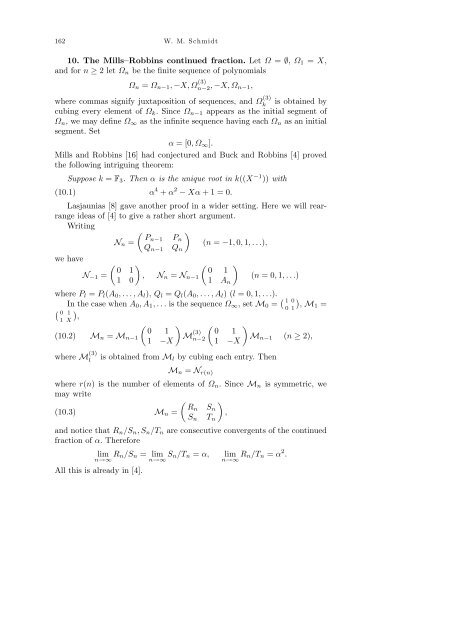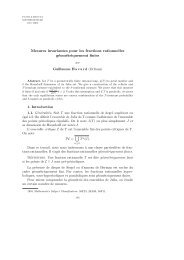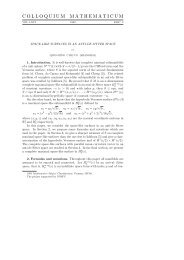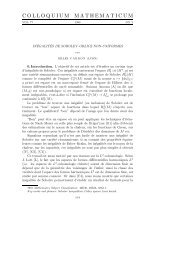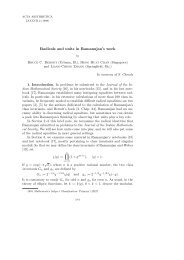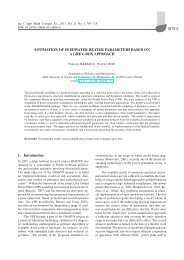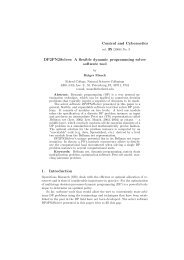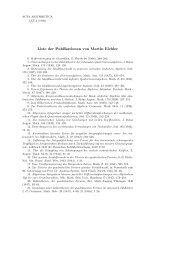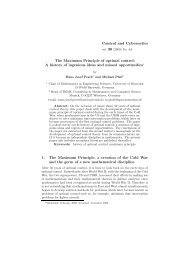On continued fractions and diophantine approximation in power ...
On continued fractions and diophantine approximation in power ...
On continued fractions and diophantine approximation in power ...
You also want an ePaper? Increase the reach of your titles
YUMPU automatically turns print PDFs into web optimized ePapers that Google loves.
162 W. M. Schmidt<br />
10. The Mills–Robb<strong>in</strong>s <strong>cont<strong>in</strong>ued</strong> fraction. Let Ω = ∅, Ω1 = X,<br />
<strong>and</strong> for n ≥ 2 let Ωn be the f<strong>in</strong>ite sequence of polynomials<br />
Ωn = Ωn−1, −X, Ω (3)<br />
n−2 , −X, Ωn−1,<br />
where commas signify juxtaposition of sequences, <strong>and</strong> Ω (3)<br />
k is obta<strong>in</strong>ed by<br />
cub<strong>in</strong>g every element of Ωk. S<strong>in</strong>ce Ωn−1 appears as the <strong>in</strong>itial segment of<br />
Ωn, we may def<strong>in</strong>e Ω∞ as the <strong>in</strong>f<strong>in</strong>ite sequence hav<strong>in</strong>g each Ωn as an <strong>in</strong>itial<br />
segment. Set<br />
α = [0, Ω∞].<br />
Mills <strong>and</strong> Robb<strong>in</strong>s [16] had conjectured <strong>and</strong> Buck <strong>and</strong> Robb<strong>in</strong>s [4] proved<br />
the follow<strong>in</strong>g <strong>in</strong>trigu<strong>in</strong>g theorem:<br />
Suppose k = F3. Then α is the unique root <strong>in</strong> k((X −1 )) with<br />
(10.1) α 4 + α 2 − Xα + 1 = 0.<br />
Lasjaunias [8] gave another proof <strong>in</strong> a wider sett<strong>in</strong>g. Here we will rearrange<br />
ideas of [4] to give a rather short argument.<br />
Writ<strong>in</strong>g<br />
<br />
Pn−1 Pn<br />
Nn =<br />
(n = −1, 0, 1, . . .),<br />
we have<br />
N−1 =<br />
Qn−1 Qn<br />
<br />
<br />
0 1<br />
0 1<br />
, Nn = Nn−1<br />
1 0<br />
1 An<br />
(n = 0, 1, . . .)<br />
where Pl = Pl(A0, . . . , Al), Ql = Ql(A0, . . . , Al) (l = 0, 1, . . .).<br />
In the case when A0, A1, . . . is the sequence Ω∞, set M0 = 1 0 <br />
, M1 =<br />
0 1<br />
0 1 <br />
,<br />
1 X<br />
<br />
0 1<br />
(10.2) Mn = Mn−1<br />
M<br />
1 −X<br />
(3)<br />
<br />
0 1<br />
n−2<br />
Mn−1 (n ≥ 2),<br />
1 −X<br />
where M (3)<br />
l<br />
is obta<strong>in</strong>ed from Ml by cub<strong>in</strong>g each entry. Then<br />
Mn = N r(n)<br />
where r(n) is the number of elements of Ωn. S<strong>in</strong>ce Mn is symmetric, we<br />
may write<br />
(10.3)<br />
<br />
Rn<br />
Mn =<br />
<br />
Sn<br />
,<br />
Sn Tn<br />
<strong>and</strong> notice that Rn/Sn, Sn/Tn are consecutive convergents of the <strong>cont<strong>in</strong>ued</strong><br />
fraction of α. Therefore<br />
lim<br />
n→∞ Rn/Sn = lim<br />
n→∞ Sn/Tn = α, lim<br />
n→∞ Rn/Tn = α 2 .<br />
All this is already <strong>in</strong> [4].


